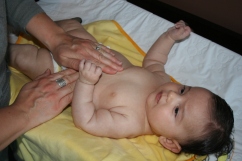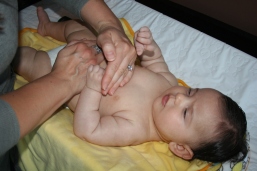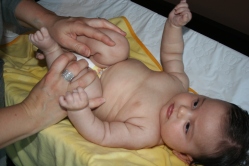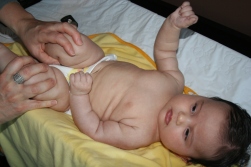The other day my littlest love, Jenna (2 1/2 months), was fussier than normal. I wanted to think that she was really sad that I was returning to work the next day . . . as I was . . . but I realized it was just that she was a bit gassy! Abdominal massage is a wonderful technique to ease gas pain, to improve digestion and to aide in constipation issues for little ones.
In my practice as a pediatric physical therapist, I never thought I would be so concerned about pooping and gassiness. But it does affect how a baby acts and how happy they are, therefore it is a main concern of mine that babies are elimintating effectively and that the mommy/baby couplet are happy together! I am often instructing abdominal massage to new moms, whether it is in the NICU to help a fussy baby or a baby with constipation or in the outpatient clinic to provide a technique to help a Mom who is sad and upset that her baby is always gassy and fussy. I also provide screeings for babies at the breastfeeding support group at the hospital where I work. More often than not, one Mom expresses concern that her baby is gassy and I have a group of Moms that join in for the instruction because they have the same concern.
It is important to know why abdominal massage works. It is not magic . . . it is just anatomy! The ascending colon runs from right above the pelvis to under the rib cage. The transverse runs across the belly below the rib cage and the descending colon runs from under the left side of the rib cage to the left side just above the pelvis. (click here to see an anatomical view!). An infant’s rib cage is elevated and compact, so the belly is just waiting to be massaged!
So, even though I, of course, had a number of other things to do that night, I hunkered down for a few minutes and helped Jenna to ease her pain. It really does only take a few minutes . . .
General instructions –
- I have found abdominal massage effective over clothes or on skin. I have found it is effective without oil or lotion, but if you are massaging your baby otherwise, or lotioning baby after a bath, it is great to use the lotion in the massage.
- If possible try to avoid these massages just after baby eats as it does put a lot of pressure on the abdominal area and can make the baby spit up.
- Make sure you read your baby, if your baby is fussing more than normal, check your pressure, maybe you are too tense and pressing too hard. The pressure used should be a firm, but gentle touch.
- Do each exercise for 2 minutes for 2-3 times per day.
- You may hear release of gas or stool while doing these techniques . . . hooray for you (and baby). . . it’s working!
1. Rainbow Massage (AKA I love you massage)- In this technique you are massaging the descending, transverse and ascending colon in order to help push the gas or other contents out.
You start by placing one hand on the upper left abdomen just under the rib cage and massage down toward the left pelvis. Then you massage from the right upper abdomen just below the rib cage across to the left abdomen below the rib cage and follow the first line. Finally, you massage from the right lower abdomen just above the pelvis, to the right upper abdomen just below the rib cage, across to the left upper adomen and then down to the left lower abdomen. So, you are massaging the descending colonfirst, the transverse and descending colon second and finally ascending, transverse and descending colon. You want to use a firm, but gentle pressure with three fingers. When doing this technique, you want to be sure you are constant with your touch, alternating hands with each stroke.
2. Waterfall – Make a C with your hands.
Use the pinky side of your hands to gently but firmly massage from the baby’s rib cage down to his or her pelvis. If your baby still has his or her umblilical cord, you may want to wait a few days for this one until the cord falls off. If your baby has an umbilical hernia, on the other hand, it is ok to do this technique. Alternate your hands so that you have continuous pressure.
3. Knees to belly – Bring baby’s legs up toward the right side of the abdomen, keep pressure across the abdomen as you press baby’s legs into his or her belly toward the left side and then bring legs down toward the surface.
4. Bicycles – Pelvic rotation is the key to elimination . . . bicycles help baby to rotate his or her pelvis in order to eliminate effectively. Infants do a lot of random kicking, this random kicking helps to rotate their pelvis and helps baby to elimiate effectlvey and get rid of gas. You can facilitate more of the pelvic rotation by doing bicycles with baby.
To do this, hold around the lower leg of baby with your palms facing up or down. Bring baby’s legs toward her belly and give gentle but firm pressure to the belly, then switch.
5. Snuggle – The last but most important step is to snuggle with baby. These massages can be uncomfortable and sometimes stressful for baby. So be sure to give a bit of love afterwards. If done regularly, your baby will be regular and more comfortable.
If your baby is often gassy, do these exercises 2-3 times per day. If your baby is sometimes gassy, do these exercises 2-3 times per day on bad days. If your baby is constipated one day, these exercises will help until your baby eliminates, done every few hours.
Happy tooting and pooping!











It’s a shame you don’t have a donate button! I’d definitely donate to this excellent blog!
I suppose for now i’ll settle for bookmarking and adding your RSS feed to my Google account.
I look forward to fresh updates and will talk about this blog
with my Facebook group. Chat soon!
LikeLike
thank you !
LikeLike
Reblogged this on Babies First Fitness and commented:
This is a must read for all moms with a new baby!
LikeLike
I love what you guys are up too. Such clever work and exposure!
Keep up the fantastic works guys I’ve incorporated you guys
to my personal blogroll.
LikeLike